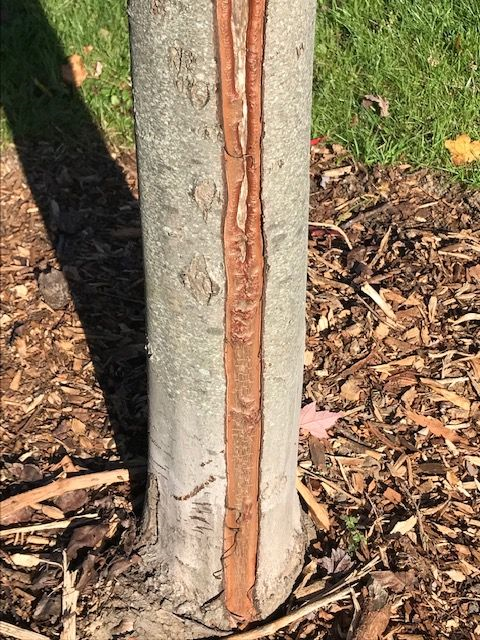Protecting Young Trees from Sunscald in Wintertime: 7 Tips
Are your young trees all set for winter? Winter in New England is hard on trees—especially young ones. So, late fall is the perfect time to start preparing young trees for the harshness of winter. This process includes protecting the bark of young trees. It often splits in the winter and can leave young trees vulnerable. Splitting is typically more severe on young trees’ south and west sides than on the north and east sides.
This splitting process is called sunscald. It occurs when the sun’s heat damages tree bark. That creates a temperature difference between internal sapwood under the bark (hot) and the external environment (cold). That, in turn, causes the sapwood to desiccate, shrink, and die. The bark eventually cracks along the dead sapwood’s fault line. Young, thin-barked ornamental and fruit trees. like birch, stewartia, red maple, London planetree, and beech are especially susceptible to sunscald.

This red maple is showing signs of sunscald, which can devastate a young tree in winter.
Sunscald occurs in summer and winter, but it is much more common in the winter. Hence, the need to start protecting young trees in the fall from this winter increases. Symptoms of sunscald include:
- Dead or discolored bark
- Vertical cracks in the bark
- Bleeding from the affected area
- Sapwood (the layer of wood just beneath the bark) that is exposed
Young trees can survive sunscald. But even if they survive it, sunscald can weaken young trees, making them more susceptible to other problems, such as pests and diseases.
Young Trees are More Susceptible
Cold weather, snow and ice, drought, salt spray, pests and diseases can severely damage trees. So, can sunscald. It can devastate them. Here are a few reasons why young trees are more vulnerable than older ones to sunscald:
- Thinner bark: Young trees have thinner bark than older trees. That’s because the tree bark thickens over time as the tree grows and ages. Thinner bark is more susceptible to damage from the sun’s heat.
- Less developed canopy: Young trees have less developed canopies than older trees. That means they have less foliage to shade the bark of the trunk. Less protection increases the chance of sunscald.
- Less experience with sunlight: Young trees have less time to adapt to sunlight than older trees. That makes them more susceptible to damage from the sun, especially if they are suddenly exposed to more sunlight than usual.
- More exposure to direct sunlight: Young trees are more susceptible to sun scald if planted in an area where they are exposed to direct sunlight for most of the day. That’s especially true in wintertime when the sun is lower in the sky than at other times, and the tree’s bark is more likely to be exposed to direct sunlight.
Protecting Young Trees from Sunscald
Tree owners can do a lot to prevent sun scald from occurring—even in the harshest New England weather. To protect young trees from sun scald, you can:
- Wrap the young tree’s trunk with a white tree wrap or plastic tree guard during the winter. The wrap reflects the sun and keeps the bark at a more constant temperature.
- Plant young trees where the elements protect them from the winter sun. The site could be in the shade of a building or another tree, or on your property’s north or northeast side.
- Water young trees regularly, especially during the first few years after planting. Watering helps them to develop a robust root system and withstand winter stresses.
- Mulch around the base of young trees. This step insulates the roots and protects them from the cold.
- Prune your trees in the late fall or early winter. This action will help to remove any dead or diseased branches that could be more susceptible to sunscald.
- Plant young trees in a location that protects them from the sun and wind, in the shade of a building or another tree, or on your property’s north or northeast side.
- Look out for pests and diseases. If you see signs of them, contact a certified arborist or RI Tree for advice.
Following these tips on combating sun scald can help protect your young trees from this sunscald and ensure they thrive for many years.
For more information on sunscald or tree care contact RITree by e-mail at ritree@ritree.org.